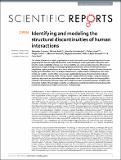Identifying and modeling the structural discontinuities of human interactions
Author(s)
H?vel, Philipp; Simini, Filippo; Vanhoof, Maarten; Smoreda, Zbigniew; Barab?si, Albert-L?szl?; Grauwin, Sebastian; Szell, Michael; Sobolevsky, Stanislav; Ratti, Carlo; ... Show more Show less
DownloadIdentifying and modeling.pdf (2.580Mb)
PUBLISHER_CC
Publisher with Creative Commons License
Creative Commons Attribution
Terms of use
Metadata
Show full item recordAbstract
The idea of a hierarchical spatial organization of society lies at the core of seminal theories in human geography that have strongly influenced our understanding of social organization. Along the same line, the recent availability of large-scale human mobility and communication data has offered novel quantitative insights hinting at a strong geographical confinement of human interactions within neighboring regions, extending to local levels within countries. However, models of human interaction largely ignore this effect. Here, we analyze several country-wide networks of telephone calls - both, mobile and landline - and in either case uncover a systematic decrease of communication induced by borders which we identify as the missing variable in state-of-the-art models. Using this empirical evidence, we propose an alternative modeling framework that naturally stylizes the damping effect of borders. We show that this new notion substantially improves the predictive power of widely used interaction models. This increases our ability to understand, model and predict social activities and to plan the development of infrastructures across multiple scales.
Date issued
2017-04Department
Massachusetts Institute of Technology. Department of Urban Studies and Planning; Massachusetts Institute of Technology. Media LaboratoryJournal
Scientific Reports
Publisher
Nature Publishing Group
Citation
Grauwin, Sebastian, Michael Szell, Stanislav Sobolevsky, Philipp Hövel, Filippo Simini, Maarten Vanhoof, Zbigniew Smoreda, Albert-László Barabási, and Carlo Ratti. “Identifying and Modeling the Structural Discontinuities of Human Interactions.” Scientific Reports 7 (April 26, 2017): 46677.
Version: Final published version
ISSN
2045-2322